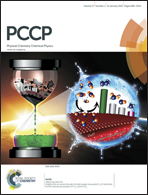Mechanical deformation mechanisms and properties of amyloid fibrils
Abstract
Amyloid fibrils have recently received attention due to their remarkable mechanical properties, which are highly correlated with their biological functions. We have studied the mechanical deformation mechanisms and properties of amyloid fibrils as a function of their length scales by using atomistic simulations. It is shown that the length of amyloid fibrils plays a role in their deformation and fracture mechanisms in such a way that the competition between shear and bending deformations is highly dependent on the fibril length, and that as the fibril length increases, so does the bending strength of the fibril while its shear strength decreases. The dependence of rupture force for amyloid fibrils on their length is elucidated using the Bell model, which suggests that the rupture force of the fibril is determined from the hydrogen bond rupture mechanism that critically depends on the fibril length. We have measured the toughness of amyloid fibrils, which is shown to depend on the fibril length. In particular, the toughness of the fibril with its length of ∼3 nm is estimated to be ∼30 kcal mol−1 nm−3, comparable to that of a spider silk crystal with its length of ∼2 nm. Moreover, we have shown the important effect of the pulling rate on the mechanical deformation mechanisms and properties of amyloid fibril. It is found that as the pulling rate increases, so does the contribution of the shear effect to the elastic deformation of the amyloid fibril with its length of <10 nm. However, we found that the deformation mechanism of the amyloid fibril with its length of >15 nm is almost independent of the pulling rate. Our study sheds light on the role of the length scale of amyloid fibrils and the pulling rate in their mechanical behaviors and properties, which may provide insights into how the excellent mechanical properties of protein fibrils can be determined.


 Please wait while we load your content...
Please wait while we load your content...